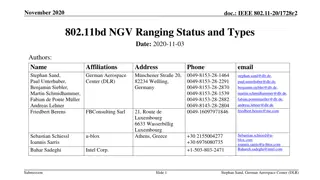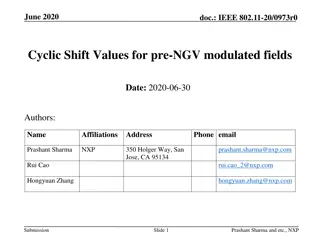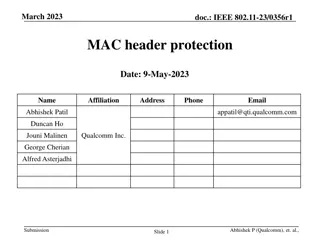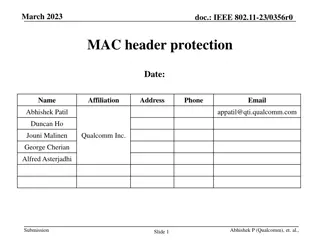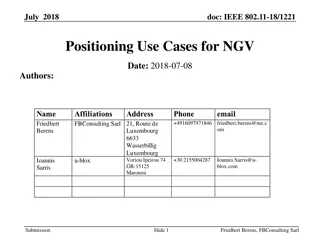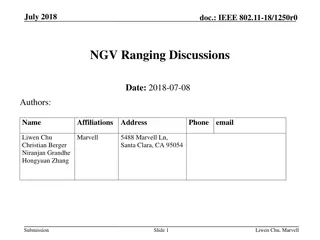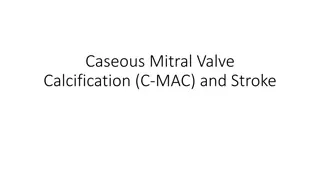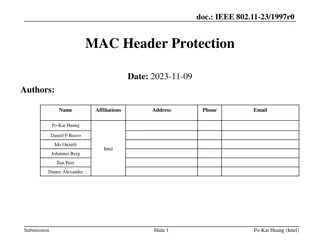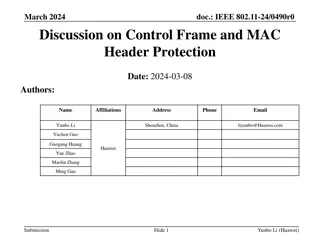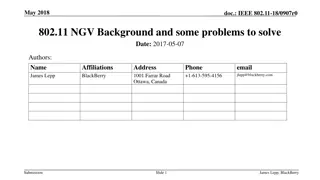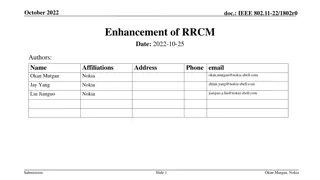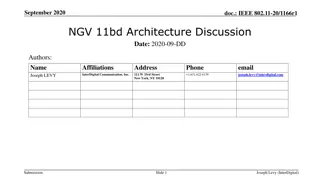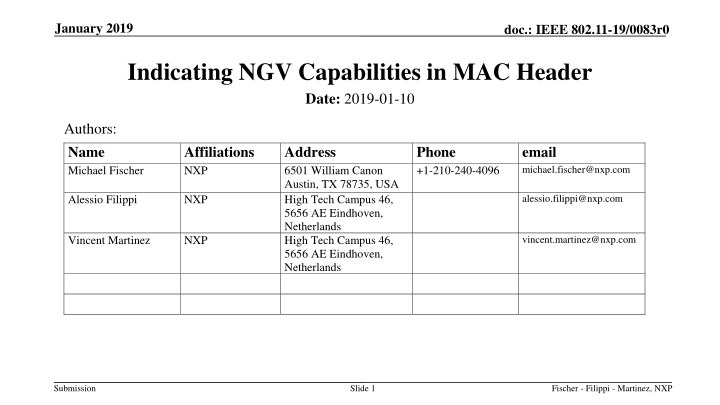
Indicating NGV Capabilities in MAC Header for V2X Enhancements
Learn how to indicate NGV capabilities in MAC headers for V2X enhancements, ensuring interoperability and backward compatibility with legacy 802.11p stations. The proposal involves utilizing specific Duration/ID field formats to convey NGV capabilities efficiently while maintaining existing communication standards.
Download Presentation

Please find below an Image/Link to download the presentation.
The content on the website is provided AS IS for your information and personal use only. It may not be sold, licensed, or shared on other websites without obtaining consent from the author. If you encounter any issues during the download, it is possible that the publisher has removed the file from their server.
You are allowed to download the files provided on this website for personal or commercial use, subject to the condition that they are used lawfully. All files are the property of their respective owners.
The content on the website is provided AS IS for your information and personal use only. It may not be sold, licensed, or shared on other websites without obtaining consent from the author.
E N D
Presentation Transcript
January 2019 doc.: IEEE 802.11-19/0083r0 Indicating NGV Capabilities in MAC Header Date: 2019-01-10 Authors: Name Michael Fischer Alessio Filippi Affiliations NXP Address 6501 William Canon Austin, TX 78735, USA High Tech Campus 46, 5656 AE Eindhoven, Netherlands High Tech Campus 46, 5656 AE Eindhoven, Netherlands Phone +1-210-240-4096 email michael.fischer@nxp.com alessio.filippi@nxp.com NXP vincent.martinez@nxp.com Vincent Martinez NXP Submission Slide 1 Fischer - Filippi - Martinez, NXP
January 2019 doc.: IEEE 802.11-19/0083r0 Abstract NGV stations must have a means to detect each other It is highly desirable for this indication of NGV capability be included in legacy 802.11p frames sent by NGV stations so that NGV stations can detect each other while sending frames that are already required for legacy communication Any such indication must be encoded in a manner that does not affect interoperability, coexistence, backward compatibility, or fairness with legacy 802.11p stations It is highly desirable that this means be extensible to multiple capabilities If NGV is successful, there will eventually be other generations of V2X enhancements The Duration/ID field of the MAC header can be used for this purpose If this indication is included in 802.11p broadcast PPDUs sent in a 10MHz channel, up to five capability bits are available Submission Slide 2 Fischer - Filippi - Martinez, NXP
January 2019 doc.: IEEE 802.11-19/0083r0 Background format of the Duration/ID field Duration/ID field is 16 bits long and directly follows the Frame Control field in the MAC header In Data type frames the Duration/ID field contains a duration (in units of microseconds) in bits 14 through 0, and bit 15 equal to zero Submission Slide 3 Fischer - Filippi - Martinez, NXP
January 2019 doc.: IEEE 802.11-19/0083r0 Using the duration value to indicate NGV capabilities In group-addressed data frames the duration value is specified to be zero So OCB broadcast data frames sent by legacy 802.11p stations will always have duration=0 Therefore, NGV-capable stations can use a (limited range) of non-zero duration values in OCB broadcast data frames to indicate capabilities, while retaining full interoperability and backward compatibility with 802.11p Duration values less than the SIFS time cannot affect channel access, because, even if such a value were used to update the NAV, that NAV setting will expire before the earliest time that channel state (NAV or CCA) is used For legacy 802.11p operating in a 10MHz channel, duration values in the range [0:31] are always safe (because SIFS is 32 microseconds) Accordingly, duration bits 4:0 can be used to indicate NGV capabilities Submission Slide 4 Fischer - Filippi - Martinez, NXP
January 2019 doc.: IEEE 802.11-19/0083r0 Proposed encoding of NGV capabilities (1) In OCB broadcast data frames: Duration = 0 indicates legacy 802.11p capabilities only Duration = 1 indicates 802.11p and 802.11bd capabilities Duration > 1 reserved for future extensions And can also be used for NGV options that are not part of basic NGV capability (if any) Bit 0 IEEE 802.11bd (NGV) support Bit 1 reserved for future standard support Bit 2 reserved for future standard support Bit 3 reserved for future standard support Bit 4 reserved for future standard support Exact usage open for discussion Submission Slide 5 Fischer - Filippi - Martinez, NXP
January 2019 doc.: IEEE 802.11-19/0083r0 Proposed encoding of NGV capabilities (2) The proposed encoding is shown in the following table. Rows below IEEE 802.11bd are speculative and shown for example only Bit 0 Bit 1 Bit 2 Bit 3 Bit 4 IEEE 802.11bd (NGV) support IEEE 802.11bd+ support IEEE 802.11bd++ support reserved reserved IEEE 802.11p 0 0 0 0 0 IEEE 802.11bd 1 0 0 0 0 IEEE 802.11bd+ 1 1 0 0 0 Etc Possible selective legacy support 1 1 0 1 1 IEEE 802.11bd++++ 1 1 1 1 1 Submission Slide 6 Fischer - Filippi - Martinez, NXP
January 2019 doc.: IEEE 802.11-19/0083r0 Update to Duration/ID field encoding table If this proposal is adopted, the Duration/ID field encoding table changes as shown: Bit 0-4 Bit 5-13 Bit 14 Bit 15 Usage 0-31 0 0 0 Standards capability indication for group-addressed NGV frames Duration value (in microseconds) within all frames except: PS-Poll frames transmitted during the CP frames transmitted during the CFP using the HCF Fixed value under point coordination function (PCF) within frames transmitted during the CFP. Reserved Reserved AID in PS-Poll frames. Reserved 0 0 32 767 0 0 1 0 1 1 16 383 0 1 1 1 1 1 2007 2008 16 383 1 1 Submission Slide 7 Fischer - Filippi - Martinez, NXP
January 2019 doc.: IEEE 802.11-19/0083r0 Is this proposed use of the Duration/ID field safe? YES! 1. The duration value is never used for filtering, so reception is unaffected 2. NAV should not be updated using duration from a group-addressed data frame This was normative from 802.11-1997 until 802.11-2007, but no longer appears (because other parts of the relevant annex were out of date, not due to any changes about the NAV) 3. Even if the NAV is updated using this capability-indicating pseudo-duration, any value shorter than aSIFSTime will expire before the first sensing of the medium after PHY-RXEND.indication, so medium access is unaffected 4. By limiting capability indication to group-addressed OCB data frames, this technique will never interfere with cases where unicast data frames, or other frame types, do contain durations that are needed for NAV update Submission Slide 8 Fischer - Filippi - Martinez, NXP
January 2019 doc.: IEEE 802.11-19/0083r0 Summary We propose to encode capabilities to support NGV, and subsequent vehicular amendments, using non-zero duration values in legacy 802.11p group- addressed data frames sent by NGV-capable stations At least five capability bits can be represented in a fully interoperable and backward-compatible manner, which leaves space to indicate additional, future capablities Placing this capability indication in the MAC header rather than in a PHY field is more efficient, because no symbols are added, and more reliable, because the MAC header is CRC-protected Submission Slide 9 Fischer - Filippi - Martinez, NXP



